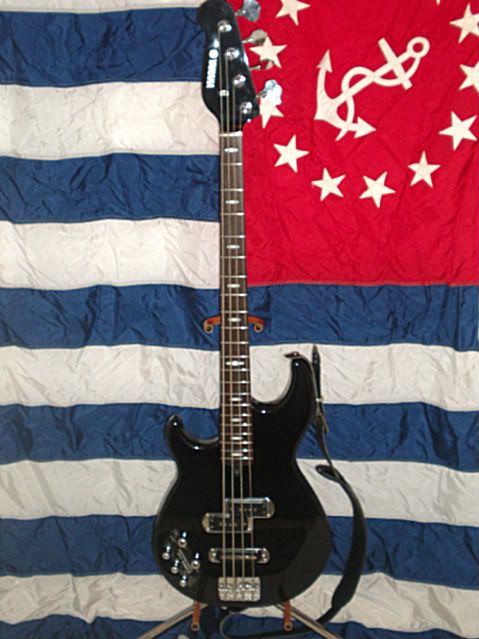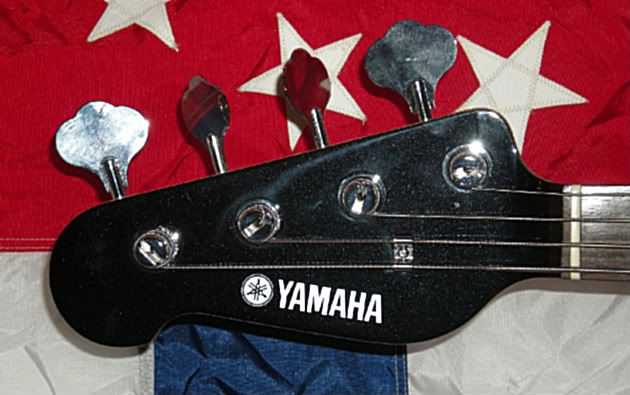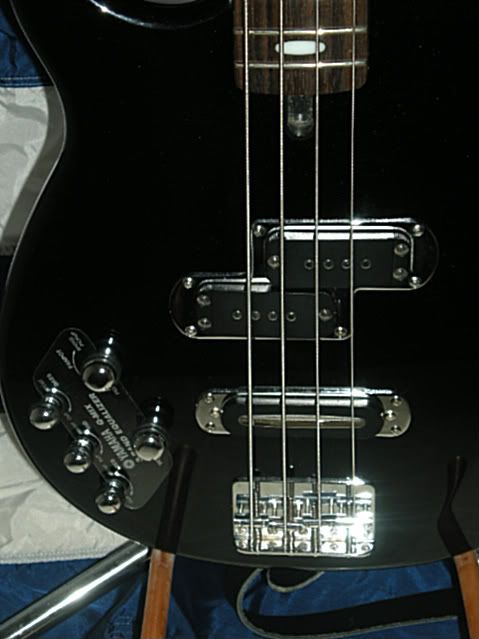|
I own one of each, the passive BB414 and the active BB614 (in addition to a vintage BB1600, BB1200, and BB1200S- the "Peter Hook" model- but I'll get into the vintage Yammies at another time). While obviously not in the same league with the old vintage stuff, both the 414 and 614 deliver extremely high "bang for the buck" ROI- and being Yamahas, they are still a bit off the mainstream path which is a nice plus. Given the limited alternatives for decent inexpensive "off the rack" lefties with personality, I'm surprised that everybody on here hasn't already picked up one or the other of these! So I thought it might be helpful to share some quick observations for those still thinking about it.
For starters, here's a Hands On review from the Musician's Friend site that pretty accurately reflects my own opinions; I'll highlight some points that I think are particularly on target:
Yamaha BB Series Basses: Blast from the past
By James Nichols
Yamaha never has a shortage of killer basses in its stable, as endorsers like Billy Sheehan and John Patitucci will testify. So I guess I shouldn't have been surprised when I picked up the recently reissued BB Series basses and was completely knocked out. Why was I? In a word: economics. The new BBs play way above their low street prices.
History
The BB Series got started with the BB1200, BB2000, and BB3000 at the dawn of the '80s. All three garnered a cult following thanks to their outstanding playability, tone, and quality. Unfortunately, with their (at that time) exotic maple-and-mahogany neck-thru construction and relatively unknown status in the American bass market, the BBs were never a contender for the bass crown.
In the '90s Yamaha gave the series a facelift modeled on the Nathan East signature bass. The new BB models were well received, but some players still craved the original BB. Vintage BBs and custom models from the North Hollywood Yamaha Guitar Development Custom Shop found fans in pros like Michael Anthony of Van Halen (who has a signature model BB), resident ATLien groover Preston Crump, and Tony Kanal of No Doubt. The YGD shop listened to all these artists and was responsible for drawing up designs for the new production models.
New age
I checked out the passive, four-string BB414 and the active BB614. Both felt bulletproof with an exceptional level of fit and finish even the most critical player could approve. The basics of construction are about as traditional as it gets: alder body, bolt-on maple neck, rosewood fretboard, 34" scale, chrome hardware, and two pickups with chrome surrounds.
The BB series necks, finished in a clear satin, are fast and comfortable. Players used to modern jumbo frets are in for a treat with the BB's more comfortable vintage-sized units that make slides smooth as silk. And thanks to the contoured neck joint, you can slide up to the highest reaches with ease. The BB design is a winner; it's solid and old school with its own flair.
The pickups are cosmetically identical to the vintage units but feature an internal redesign. Using modern ferrite magnets, they give the BBs more attitude while retaining the classic depth you'd expect. The split-coil pickup has textured edges for easy thumb anchoring and the bridge pickup is a soapbar-style single-coil with an exposed, curved blade. Installed in the large alder slab body, they deliver tone for days.
Fresh recruits
The active BB614 is a remarkably good-natured bass that's sonically smooth and even. Its chrome knobs control master volume, pickup blend, and the 9V-powered three-band EQ. With center detents, the EQ is a cut/boost affair that delivers predictable, but not boring, results: adding bass, mids, and treble delivered more boom, punch, and sizzle, respectively. Pulling out some mids and boosting the bass and treble knobs just a bit gave me a cutting finger-style sound. Dialing in some lows and mids gave my pickwork grinding heft.
The passive BB414 has that extra something that made me pick it up over and over again. I can best describe its sound as deep, warm, and expressive without being hyped at all. Plus it outplays a lot of pricier American-made basses. Its output is hot, but not so hot that you lose all dynamics; it remains responsive and articulate no matter the playing style. Dialing in tones on the fly is easy thanks to speed knobs with textured edges and a three-way pickup selector. I loved it so much I used it to lay down some tracks with my band, and they dug it too.
It's rare to play a bass that has it completely together. It's even rarer when that bass has an affordable price tag attached. If you're looking for a workhorse companion to join you on your low-frequency adventures, you really can't go wrong with a BB.
I also love the neck on these, faster and more comfortable for me than my vintage BB1200 necks, much more like the vintage BB1600 neck which is closer to a Jazz than P bass profile.
Beyond that, there are a few gripes I have with Yamaha relative to these basses (but nothing that should stop anyone from picking one up):
• Lefties get black only: Righties get choice of Orange Metallic, Wine Red Burst, or Vintage White finishes.
• The control setups on both basses could be better: The 614 would be the clear choice if it could also produce the same warm passive thump that the 414 has- but since there’s no active/ passive switching, you can’t. I’m pretty sure the pickups are identical in both basses, and don’t get me wrong, the 614’s electronics are very good sounding for an inexpensive active bass, but the closest you can get to the 414’s excellent passive tone is a simulated, more sterile version. Meanwhile, the 414 comes with a 1 vol/ 1 tone/ 3-way switch setup (like the old BB1200). This drives me nuts on a 2 pickup bass. Although it sounds great and the range of the tone knob is decent, you could dial in dozens more tonal variations if it had a 2 vol/ 2 tone control setup, or even a 1 vol/ 1 bal/ 1 tone (like the old BB1600).
So what you have are two basses that both sound good and are great players, but also sound distinctly different from each other; to get the whole tonal package you’d have to get them both- and I guess that's why I still have them both (I had originally planned to sell the 414 when I got the 614). If you are an active fan, or in need of an active bass to round out the herd, go with the 614. If you’re a traditionalist or looking for a more “old school” tone, go with the 414. If I had to pick one... like the reviewer I find myself going for the 414 more often. The price difference is pretty minimal so it’s really more a question of what you’re looking for.
| Attachments: |

yamaha2.jpg [ 87.66 KiB | Viewed 12014 times ]
|
|






